(Adds currency trader comment, updates prices to close)
* Canadian dollar settles at C$1.3160, or 75.99 U.S. cents
* Loonie touches its weakest since July 27 at C$1.3236
* Bond prices mixed as yield curve steepens
By Alastair Sharp
TORONTO, Sept 15 (Reuters) - The Canadian dollar recovered from a seven-week low against its U.S. counterpart on Thursday as a partial reversal of a recent oil price slump provided support to the commodity-linked currency.
"Oil had a rough start to the week," said Blake Jespersen, managing director for foreign exchange sales at BMO Capital Markets. "It's had a very modest rally today, so that's helped the Canadian dollar recoup some of its losses."
The loonie, as Canada's currency is colloquially known, lost more than 1 percent of its value in the first three days of the week, as oil prices fell sharply on warnings from producer and consumer groups that a glut will take longer to clear.
The Canadian dollar CAD=D4 settled at C$1.3160 to the greenback, or 75.99 U.S. cents, stronger than Wednesday's close of C$1.3197, or 75.77 U.S. cents.
The currency's strongest level of the session was C$1.3131, while it touched its weakest since July 27 at C$1.3236.
Oil prices LCOc1 CLc1 rose about 1 percent after shedding 6 percent in the past two days. O/R
Jespersen said he expects Canadian dollar strength to stall around C$1.27 or C$1.28, while it could weaken to C$1.35 if the Federal Reserve moves closer to hiking U.S. interest rates and commodity prices remain subdued.
The U.S. dollar .DXY seesawed against a basket of major currencies after retail sales and industrial production data disappointed. household debt as a share of income hit a record high in the second quarter, Statistics Canada data showed in a report likely to reinforce concerns of overborrowing by consumers. of existing Canadian homes fell 3.1 percent in August from July, the fourth straight monthly decline and the largest drop in nearly two years, a report from the Canadian Real Estate Association showed. Still, actual sales, not seasonally adjusted, were up 10.2 percent from August 2015. government bond prices were mixed across the yield curve. The two-year CA2YT=RR price rose 2 Canadian cents to yield 0.575 percent, while the benchmark 10-year CA10YT=RR fell 12 Canadian cents to yield 1.200 percent.
The curve steepened as the spread between the two- and 10-year yields widened by 2.4 basis points to 62.5 basis points, indicating underperformance for longer-dated bonds.
